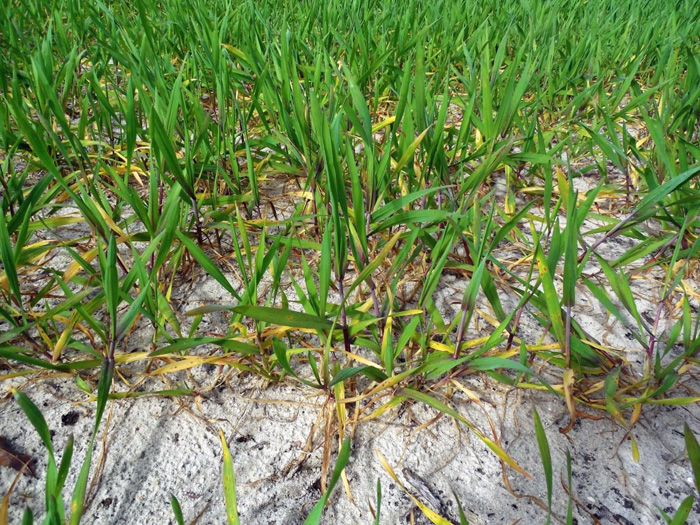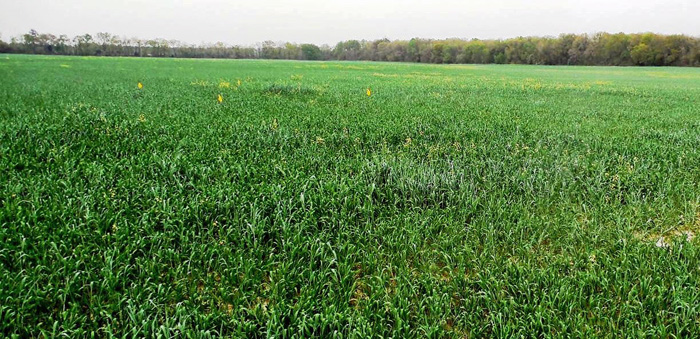
Figure 1. Nitrogen deficient triticale forage. Notice older leaves are yellow and stems have a purple cast. Photo credit: Cheryl Mackowiak
Cheryl Mackowiak, UF/IFAS NFREC Soils Specialist
Cool-season forages took a hit this year from challenging growing conditions. Summer extended into winter, so perennial summer grasses remained competitive with the cool-season forage plantings all the way into December and January. Diseases were much more plentiful, particularly on fall-planted annual ryegrass. In addition, heavy fall and winter rains resulted in wasted fertilizer applications, as nutrients (nitrogen, potassium, and sulfur) washed or leached beyond the reach of annual forage root systems. In general most producers are frustrated with the productivity of their winter forages this season. Fields are pale and stunted, when they are normally lush green and abundant at this point in the year. This leads to the key question, “Is it worth trying to salvage some cool-season forage production this late in the season?” The short answer is maybe.
The following are some general observations that may help with your decision-making. In addition, you should consider contacting your local county extension agent for further consultation if your options seem unclear, or if a poor choice might result in additional financial hardship.
- To keep small grains forages (wheat, cereal rye, triticale, oats) productive longer, it is best to prevent head formation by cutting or grazing. Once the heads have formed, the plants will not likely respond well to additional nitrogen fertilizer. The plant has entered its reproductive stage, when most of the nutrients are reallocated from the plant to the grain. If the plants have lots of young, non-heading tillers (shoots), then they might be somewhat more responsive (later maturing, annual ryegrass may respond for a somewhat longer period).
- If you observe leaf spotting or other foliar disease symptoms on any cool-season grass forages, you might prolong production by grazing or cutting off the forage to remove the disease inoculant. Chances are improved that the regrowth will be more vigorous and look healthier.
- If your small grains or annual ryegrass field looks uniformly yellow (particularly the oldest leaves), you may be suffering from nitrogen (N) deficiency (Figure 1 above). If your field appears more like a patchwork of yellow and green, you may have a sulfur (S) or nitrogen + sulfur deficiency (Figure 2). Luckily only 10 lbs S/A is required for a quick response (7 to 10 days). A nitrogen application response is similarly quick. Thirty to 50 lbs N/A should be sufficient for good cool-season forage recovery to salvage some of the investment made in winter.

Figure 2. Triticale field with sulfur deficiency symptoms, early March. Photo credit: Cheryl Mackowiak
- Three or more nitrogen fertilizer applications of 50 lbs N/A, or a high seasonal N application (above 80 lbs N/A) increases your risk of accumulating nitrates, particularly if used to promote regrowth following cutting or grazing. Dark green forage is beautiful to behold, but it may signal nitrate accumulation from supra-optimal N fertilizer applications (Fig. 3). Heavy forage regrowth can dilute tissue nitrogen, thereby reducing the risk of nitrate poisoning to livestock.

Figure 3. Triticale field ten days after a 28-0-0-5 application (55 lbs N/A and 10 lbs S/A. Photo credit: Cheryl Mackowiak
For more information please see the following UF/IFAS Publications:
Nitrate Poisoning in Grazing Cattle – Questions and Answers
Factors Affecting Forage Quality
- Grower Survey Insights on Cotton Nitrogen Management in Florida’s Panhandle - July 18, 2025
- Florida Soils are an Indispensable Natural Resource - January 10, 2025
- Regenerative Agriculture: What it Means to You - June 21, 2024
